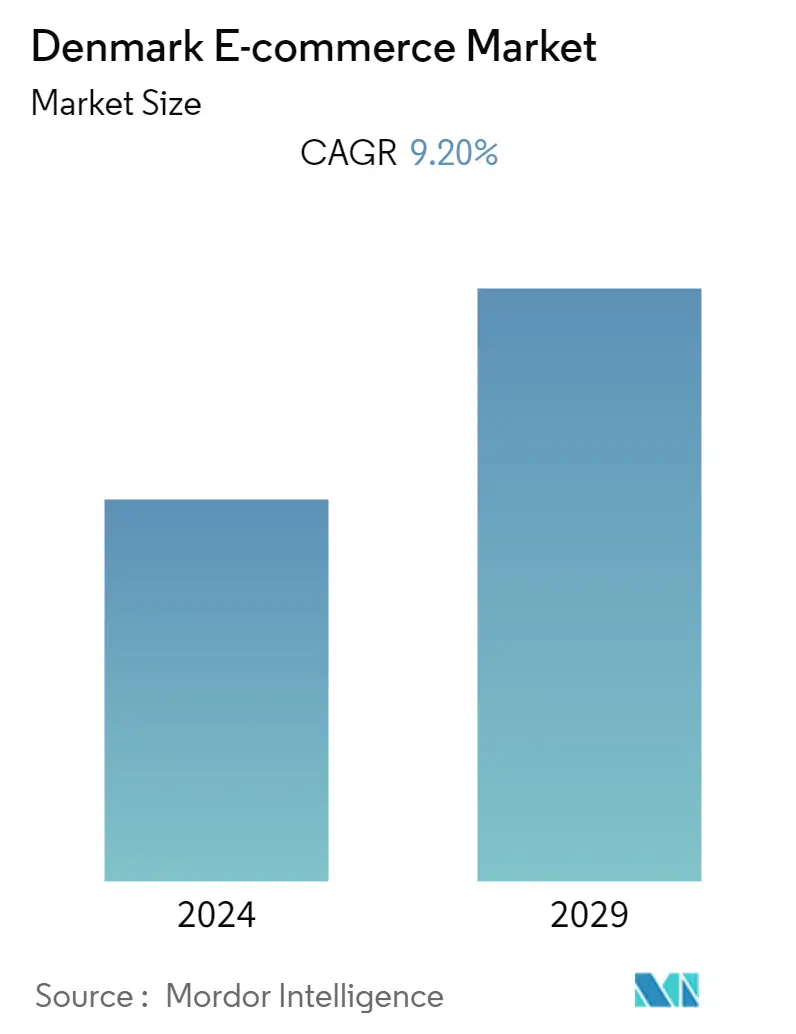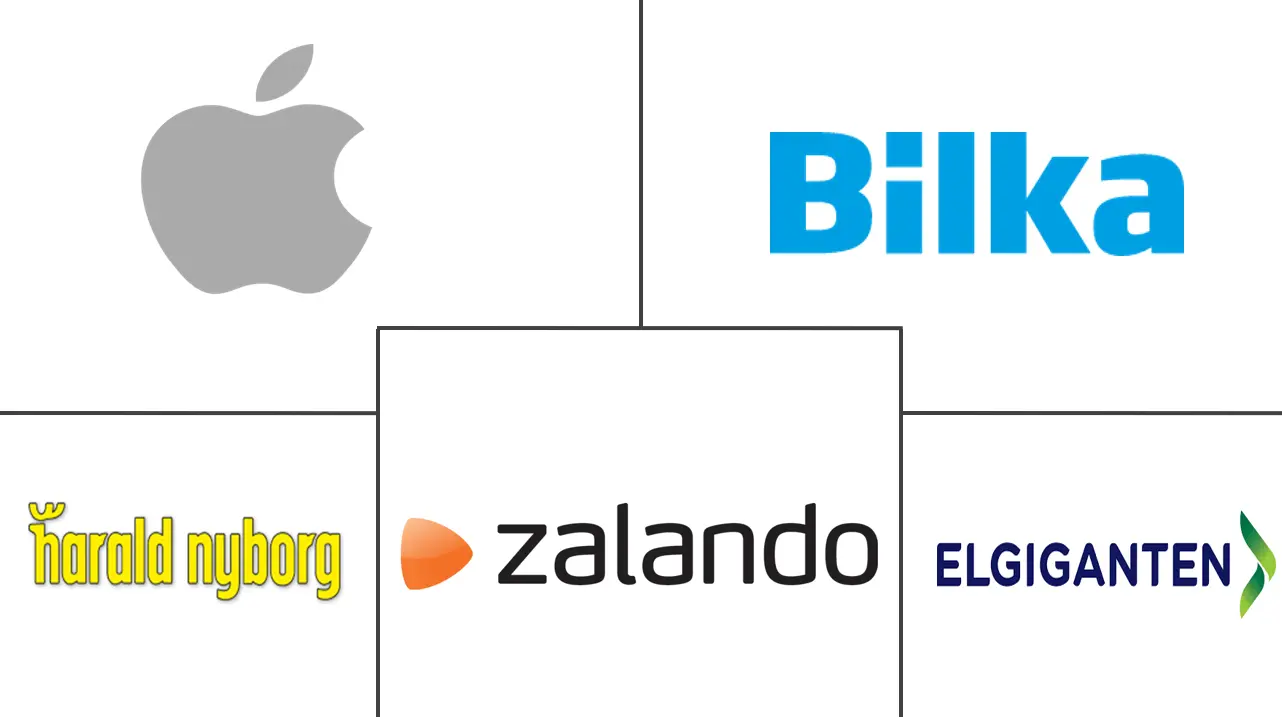Market Size of Denmark E-commerce Industry

| Study Period | 2019 - 2029 |
| Base Year For Estimation | 2023 |
| Forecast Data Period | 2024 - 2029 |
| Historical Data Period | 2019 - 2022 |
| CAGR | 9.20 % |
| Market Concentration | Low |
Major Players
*Disclaimer: Major Players sorted in no particular order |
Denmark E-commerce Market Analysis
The Denmark e-commerce market is expected to register a CAGR of 9.2% during the period 2022-2027. The market is primarily driven by advanced infrastructure, high internet penetration, and a growing number of card-based payment systems.
- Denmark is well-positioned for ongoing e-commerce growth. The region is ranked as one of the top five countries to do business with by the World Bank. International merchants find Danish e-commerce logistics and payments easy to get to grips with and set up their regional businesses. Moreover, cross-border transactions take almost a quarter of total e-commerce in Denmark, making the country an attractive proposition for international merchants.
- To access potential Danish customers via social commerce, many major market players in the region use digital advertising via Facebook. The shoppable platform has the highest reach among social media users in Denmark. As per Hootsuite, Facebook's potential advertising reach percentage of the total population is 61.8%.
- Furthermore, high internet and smartphone penetration in the region is paving the way for the e-commerce market. As per EUROSTAT, 99% of the population has access to the internet in the area.
- Moreover, Black Friday has become a key date in the Danish online shopping calendar. Danes expect good discounts over a week-long sale around the last week of November, with the event dubbed 'Black Week' in the country. Black Friday is a huge revenue opportunity for e-commerce businesses in the region.
- However, increasing fraud in payments for e-commerce or online shopping can hamper the market's growth in the region. As reported by StatBank Denmark, fraud reported in Danish payments cards in e-commerce was 2,969 in Q1 2021, and it increased to 3,492 in Q4 2021. Since most of the population in Denmark uses card payments as a preferred payment method for e-commerce purchases, increasing fraud can limit card usage in e-commerce purchases.
- The COVID-19 pandemic increased online shopping in the region. The increase in sales was present across all categories of e-commerce as consumers stayed at home during the COVID-19 outbreak to help prevent the spread of the COVID-19 virus in Denmark. Moreover, many companies have gone online or enhanced their presence due to Covid-19; this goes for B2B and B2C.
Denmark E-commerce Industry Segmentation
E-commerce is the purchasing and selling of products and services over the Internet. It is conducted over computers, mobiles, tablets, and other smart devices. There are primarily two types of e-commerce, including Business-to-Consumer (B2C) and Business-to-Business (B2B).
The Denmark E-commerce Market is segmented by B2C eCommerce (Beauty and Personal Care, Consumer Electronics, Fashion and Apparel, Food and Beverage, Furniture and Home), and B2B eCommerce.
| By B2C ecommerce | ||||||||
| Market Size (GMV) for the Period of 2017-2027 | ||||||||
|
| By B2B ecommerce | |
| Market Size for the Period of 2017-2027 |
Denmark E-commerce Market Size Summary
The Denmark e-commerce market is poised for significant growth, driven by robust infrastructure, high internet penetration, and an increasing adoption of card-based payment systems. The country is recognized as a favorable business environment, attracting international merchants with its straightforward logistics and payment processes. Cross-border transactions constitute a substantial portion of the market, enhancing its appeal to global businesses. Social commerce is gaining traction, with platforms like Facebook playing a pivotal role in reaching Danish consumers. The popularity of events like Black Friday, known locally as 'Black Week', underscores the market's potential, although challenges such as payment fraud pose risks to growth. The COVID-19 pandemic has further accelerated the shift towards online shopping, prompting both B2B and B2C sectors to enhance their digital presence.
The Danish payment landscape is dominated by card transactions, with the Dankort debit card being particularly popular due to its co-branding with Visa and absence of user fees. The decline in cash transactions is evident, with contactless payments gaining traction. The fashion segment leads e-commerce sales, with major players like Zalando and emerging platforms such as The Founded capitalizing on the demand for apparel. Streaming services and social media are increasingly used for fashion advertising, targeting younger demographics. The market is moderately fragmented, with key players actively pursuing partnerships and innovations to expand their market share. Recent acquisitions and strategic expansions by companies like A.P. Moller - Maersk and Boozt highlight the dynamic nature of the market, as businesses seek to enhance their offerings and reach in the region.
Denmark E-commerce Market Size - Table of Contents
-
1. MARKET INSIGHTS
-
1.1 Market Overview
-
1.2 Industry Attractiveness - Porter's Five Forces Analysis
-
1.2.1 Bargaining Power of Suppliers
-
1.2.2 Bargaining Power of Buyers/Consumers
-
1.2.3 Threat of New Entrants
-
1.2.4 Threat of Substitute Products
-
1.2.5 Intensity of Competitive Rivalry
-
-
1.3 Key Market Trends and Share of E-commerce of Total Retail Sector
-
1.4 Impact of COVID-19 on the E-commerce Sales
-
-
2. MARKET SEGMENTATION
-
2.1 By B2C ecommerce
-
2.1.1 Market Size (GMV) for the Period of 2017-2027
-
2.1.2 Market Segmentation - by Application
-
2.1.2.1 Beauty and Personal Care
-
2.1.2.2 Consumer Electronics
-
2.1.2.3 Fashion and Apparel
-
2.1.2.4 Food and Beverages
-
2.1.2.5 Furniture and Home
-
2.1.2.6 Others (Toys, DIY, Media, etc.)
-
-
-
2.2 By B2B ecommerce
-
2.2.1 Market Size for the Period of 2017-2027
-
-
Denmark E-commerce Market Size FAQs
What is the current Denmark E-commerce Market size?
The Denmark E-commerce Market is projected to register a CAGR of 9.20% during the forecast period (2024-2029)
Who are the key players in Denmark E-commerce Market?
Zalando.dk, Elgiganten.dk, Bilka.dk, Apple Inc. and Harald Nyborg are the major companies operating in the Denmark E-commerce Market.

